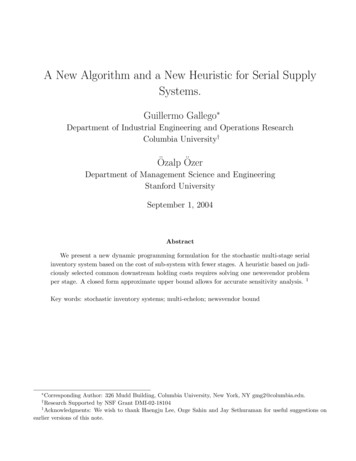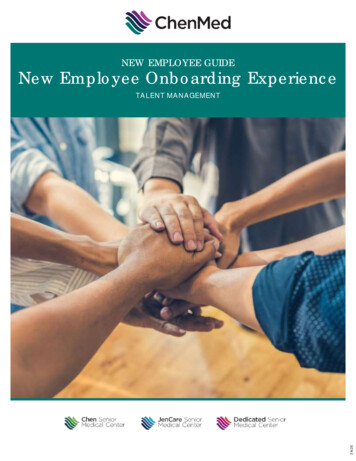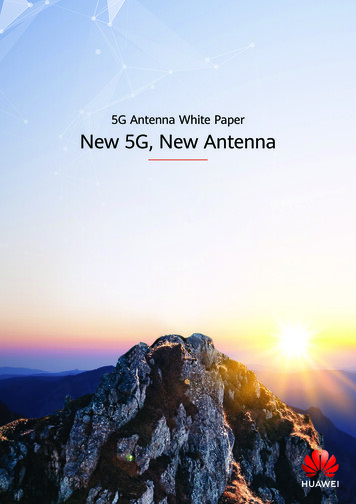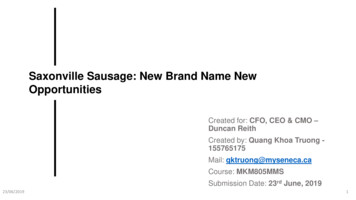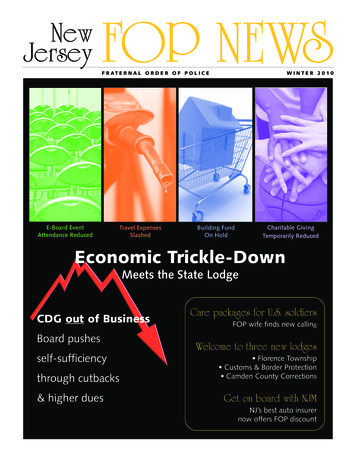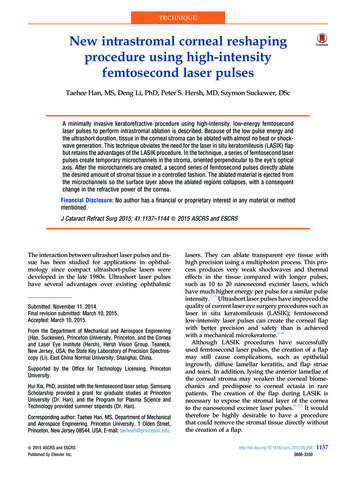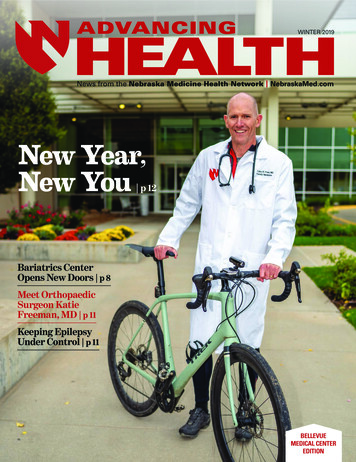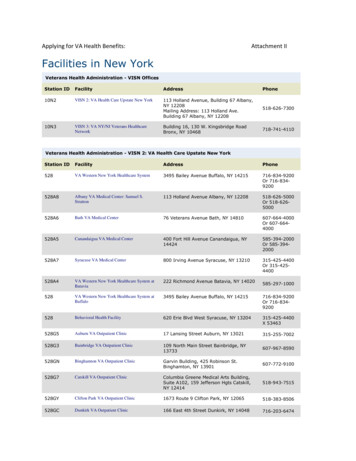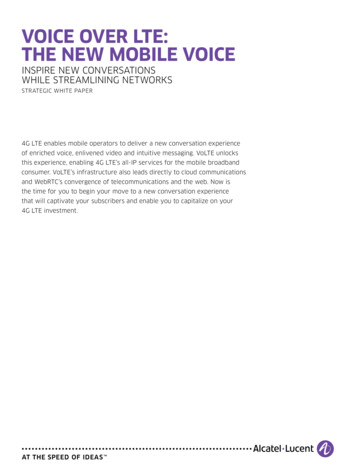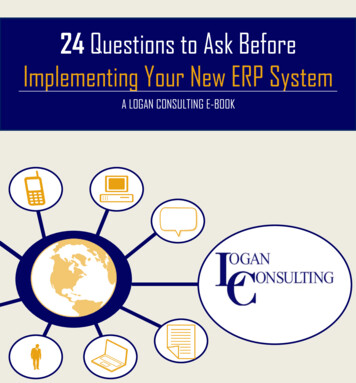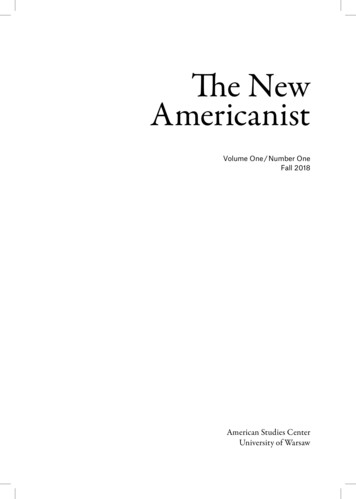
Transcription
The NewAmericanistVolume One / Number OneFall 2018American Studies CenterUniversity of Warsaw
EditorMatthew ChambersEditorial TeamAgnieszka KotwasinskaKarolina KrasuskaAdvisory BoardPaulina Ambrozy, Adam Mickiewicz UniversityCharlotte Beyer, University of GloucestershireChristopher Breu, Illinois State UniversityLori Emerson, University of Colorado BoulderKeith P. Feldman, UC BerkeleyDominika Ferens, University of WroclawPawel Frelik, Maria Curie SklodowskaUniversitySteffen Hantke, Sogang UniversityChristina Heatherton, Barnard CollegeTim Jelfs, University of GroningenReece Jones, University of HawaiiDaniel Kane, University of SussexAmy Kaplan, University of PennsylvaniaCaren Kaplan, UC DavisLaleh Khalili, SOAS University of LondonAlex Lubin, University of New MexicoJosephine Metcalf, University of HullMałgorzata Myk, University of ŁódźAndrew Pepper, Queen’s University BelfastBenjamin Railton, Fitchburg State UniversityCaroline Rody, University of VirginiaLaurence Roth, Susquehanna UniversityDavid Schmid, SUNY BuffaloJonathan Silverman, UMass LowellRoberto Tejada, University of HoustonMarek Wilczynski, University of GdanskRichard Yarborough, UCLADesignRafal Benedek and Filip Zagórski, Type2TypesettingAndrzej ZawadzkiPrinterSowa Sp. z o.oISSN 2545-3556Copyright @ American Studies Center, Warsaw 2018The New AmericanistAmerican Studies CenterAl. Niepodległości 2202-653 Warsaw t.comSubmissionsThe New Americanist is an interdisciplinary journal publishing scholarly work on the UnitedStates and the Americas broadly considered. We are especially interested in work which includes aglobal perspective, introduces new critical approaches, and proposes theoretical frameworks to thestudy of the US. We welcome contributions from scholars from around the world and across thehumanities and the social sciences.If you are interested in contributing, please submit a 350-word abstract and 200-word biographicalnote to newamericanistjournal@gmail.com. Completed articles of a 6000-8000 word lengthbased on accepted abstracts will be subjected to peer review. The New Americanist comes out twiceyearly in association with the American Studies Center, University of Warsaw. Please submitpreviously unpublished work only. All submissions will be subject to a double-blind peer review.The New Americanist is always seeking book reviews and commentary. Please contact us if you areinterested in contributing.Printed in 200 copies
TABLE OF CONTENTS5Editor’s Introduction9 Alessandro PorcoThe Life and Art of Mary Parks Washington51 Elspeth IraluTransnational American Studies as Contrapuntal Methodology71 Rikki Bettinger“Exceedingly Neat and Clean”: Household Managementin North Atlantic Women’s Travel Writings, 1800-185097 Ryan CrawfordMoby-Dick, American Studies, and the Aesthetic Education of Man123 Maarten Arnoldus(Do Not) Read the Comments: Mr. Robot and the Limitsof Critique in an Age of Narrative Excess149 Christina RileyHow the Women’s March Happened, Or, Adventures inDigital and Material Feminist Solidarity175 “Americanists in Unexpected Places”: An Interview withGeorge Blaustein, author of Nightmare Envy and OtherStories: American Culture and European Reconstruction187Book reviews225Contributors227American Studies Center Report: Jack Halberstam
Editor’s IntroductionI.The New Americanist is an interdisciplinary, peer‑reviewed journalwhich, in association with the American Studies Center at the Universityof Warsaw, publishes scholarly work on the United States and theAmericas broadly considered. The journal continues a tradition at theAmerican Studies Center of promoting international scholarship previously under the titles American Studies (1983–2005) and The Americanist(2006–2014). The New Americanist, then, is a relaunch of a long‑runningASC institution. We would like to thank ASC director Gregorz Kość forinitiating and sponsoring this venture and William Glass for giving usour initial bearings. A special mention goes to Karolina Krasuska for allthe otherwise uncredited guidance and feedback.We would also like to thank our wonderful advisory board for theirtime and assistance, as well as their commitment to this fledgling endeavour. In particular, we would like to acknowledge David Schmid, LalehKhalili, and Benjamin Railton for helping us get the ball rolling.II.The New Americanist will be released biannually–in the fall and spring–and in addition to peer‑reviewed scholarship, will publish book reviews,interviews, updates on significant ASC events, and other short features.
The New Americanist 01/2018Beginning with our third issue (Fall 2019), we will periodically run specialfeature sections with the first being “Hobgoblins of Fantasy: AmericanFantasy Fiction in Theory” guest edited by James Gifford and OrionKidder.We commit ourselves to the highest standard in publication ethics.The New Americanist publishes only original scholarship which has beensubject to double‑blind peer review. We have a strict policy against plagiarism and defamation, and we seek editorial best practices, including fairediting, avoiding conflicts of interest, and the assurance of confidentialityfor submitted work.III.Our first issue contains a great variety of topics, but one question doesreturn at moments: what is it we say we do, when we say we do AmericanStudies? Our interview with George Blaustein, the author of NightmareEnvy & Other Stories: American Culture and European Reconstruction(2018), goes some distance in attempting to answer that question historically and in our present circumstances. Ryan Crawford’s “Moby‑Dick,American Studies and the Aesthetic Education of Man,” which focuseson the history of the book’s reception, touches on some similar concernsraised in the interview: in particular, their own various attitudes for thelost significance of F.O. Matthiessen’s American Renaissance and the roleof an ideological nationalism at the heart of the early disciplinary development of American Studies. But rather than settle the question of whatwe are doing, The New Americanist aims to point that question outwardas a productive challenge.This issue, then, opens with Alessandro Porco who, quoting NathanielMackey, argues for the importance of “discrepant engagement,” or the “heterogeneity and mix” which works against “totalizing paradigms.” In Porco’s“The Life and Art of Mary Parks Washington,” an exhaustively researchedbut highly readable essay, he recovers the career of a vital African Americanartist marginalized by more standard accounts of Black Mountain Collegeor the Black Arts Movement, in both of which she was involved. ElspethIralu argues for a similar conceptualization for transnational AmericanStudies, using Edward Said’s notion of contrapuntalism, setting togetherfour texts by Lisa Lowe, Keith Feldman, Alex Lubin, and Vijay Prishad,to challenge self‑contented conceptualizations of what is possible for thediscipline. In that vein, there is Maarten Arnoldus’s analysis of the failedpromise of the counter‑hegemonic in Mr. Robot as discerned from a review6
Introduction 7of A.V. Club viewer comments in his “(Do Not) Read the Comments: Mr.Robot and the Limits of Critique in an Age of Narrative Excess.”Another archival‑based project included in this issue focuses on women’s travel writings. Rikki Bettinger, in ““Exceedingly Neat and Clean”:Household Management in North Atlantic Women’s Travel Writings,1800–1850,” uses the journals of four women travelers across four geographically distinct areas in the first half of the nineteenth century inorder to demonstrate ideological and social links across the Americasduring this period, as well as, in her words, demonstrate “the ways inwhich the women were transmitters of a racialized and gendered hierarchy.” Moving from the nineteenth century to the present day, ChristinaRiley’s “How the Women’s March Happened, or, Adventures in Digitaland Material Feminist Solidarity,” details the build up and organizationof the 2017 Women’s March in order to analyze how race‑based, but alsogeographical, economic, and ableism issues interpenetrated to shape whatproved to be a massive grassroots campaign. Riley’s focus on Facebook asthe medium through which most of these concerns played out is also especially timely as the platform has been at the center of controversies overthe 2016 election and privacy issues.The New Americanist will also strive to provide a fulsome book review section, as we believe an important function of an academic journalis to not only evaluate and discern, but also disseminate and promote.We are especially delighted to have reviews by Laleh Khalili on CarenKaplan’s Aerial Aftermaths: Wartime from Above (2017), Dani Spinosaon Safiya Umoja Noble’s Algorithms of Oppression: How Search EnginesReinforce Racism (2017), and many more. We hope to present reviewson a diverse range of topics, and we are always open to suggestions andcontributions.Finally, The New Americanist will run a backpage feature every issue detailing a recent event at the ASC. In this issue, we have a reportby Jedrzej Burszta on Jack Halberstam’s December 2017 visit to the ASC.The New Americanist announces calls for papers for every issue, butwe welcome abstract proposals at any time. Please submit a 350‑wordabstract and 200‑word biographical note to newamericanistjournal@gmail.com.
The Life and Art of Mary Parks WashingtonAlessandro PorcoABSTRACTThis essay presents a critical biography of African American visualartist Mary Parks Washington, with an emphasis on her creative de‑velopment from 1942 to 1979. Washington’s extant art is discussedin the context of her educational background, social network, andpolitical affiliations, as well as the history of activist curation in thewake of the Black Arts and Black Power Movements. As an under‑graduate at Spelman College in the 1940s, Washington was mentoredby muralist Hale Woodruff, who encouraged her to continue her stud‑ies at the Art Students League of New York, Black Mountain College,and the Universidad Nacional de México. These experiences intro‑duced Washington to key figures of the international and Americanavant‑gardes, including Josef Albers, Diego Rivera, and Jacob Law‑rence. In 1958, Washington settled down with her family in the BayArea, where she met poet Sarah Webster Fabio, a leading figure in theBlack Arts Movement on the West Coast. Washington and Fabio’s col‑laborative friendship over two decades culminated in 1979’s Offshootsof Roots Unknown, a series of “poem‑paintings” that elegize Washing‑My thanks to the staff at the Auburn Avenue Research Library on African American Cultureand History—especially Derek T. Mosley—for generously guiding me through Mary ParksWashington’s papers and gifting me with a copy of the catalogue for Washington’s Atlanta:Remembrances, Impressions and Reflections. In addition, my thanks to the estate of Sarah WebsterFabio for granting permission to reprint excerpts from Fabio’s poems. Research for this project wasgenerously funded by the University of North Carolina at Wilmington’s Charles L. Cahill Awards.
The New Americanist 01/2018ton’s family in early twentieth century Atlanta and, formally, deal withthe technical (and ethical) problem of remembering and representinghistory. Drawing extensively on archival materials from the AuburnAvenue Research Library on African American Culture and History,this essay recognizes Washington’s contribution to post‑WWII Afri‑can American art and documents her unique artistic trajectory, tra‑versing aesthetic, social, and political formations from pre‑Civil RightsAtlanta to the post‑Black Arts Movement Bay Area.Keywords: Mary Parks Washington; Sarah Webster Fabio; BlackMountain College; Black Arts Movement; African American visual art;Spelman College; Hale Woodruff; collaboration; history of Atlanta;transnationalismVisual artist Mary Parks Washington returned to her native Atlanta inthe spring of 1996 to celebrate the fiftieth anniversary of her graduationfrom Spelman College—and for the opening of her first one‑woman showsince 1979. From March 2 to May 23, 1996, the Auburn Avenue ResearchLibrary on African American Culture and History’s Cary‑McPheetersGallery exhibited Washington’s Atlanta: Remembrances, Impressions andReflections. The library produced a small color catalogue for the occasion;and it organized a public discussion of the artist’s work led by JenelsieHolloway, then professor emerita at Spelman.1 The well‑received exhibit featured Washington’s “histcollages,” mixed‑media pieces concernedwith the social, political, and economic history of Atlanta during the firsthalf of the twentieth century.2Washington’s experiments with histcollage started in 1976, and it washer primary mode of artistic expression in subsequent decades.3 Upon thedeath of her father, Andrew Walter Parks, in 1974, Washington inheritedhis extensive papers—boxes upon boxes of documents, both private andpublic in nature.4 She was inspired to integrate these textual materialsinto her creative practice: “I take old family documents,” she writes, “suchas insurance policies, letters[,] and contracts, and by superimposing drawings and paintings upon them, create images to tell of activities and eventsof my past.”5 Soon enough, fabrics and everyday objects (e.g., t‑shirts andsunglasses) also made it on to her canvases. Mixing visual art, documentary poetics, and autobiography, this late style represents Washington’s mostinnovative and lasting contribution to the history of African Americanart, seamlessly blending avant‑garde technique and local history.10
The Life and Art of Mary Parks Washington 11But Washington’s life as an artist has been remarkably long and rich,extending back to the 1940s. For example, in July 1946, with the financial support of the Julius Rosenwald Foundation, she travelled fromAtlanta to Western North Carolina’s Swannanoa Valley to study atBlack Mountain College (BMC), making her one of the earliest AfricanAmerican students to enroll at a white college in the Jim Crow south—nearly a decade before Justice Warren’s Brown v. Board of Education ruling. Washington often appears in historical accounts of the experimentalcollege as an exemplum of the struggle for, and success of, civil rights atmid‑century.6 Washington’s relationship to the Black Arts Movement(BAM) is less well known but equally noteworthy. She frequently collaborated with poet, scholar, and activist Sarah Webster Fabio, one of the leading figures of BAM on the West Coast—though Washington never fell inline completely with BAM’s aesthetic and political project. The purposeof my essay, then, is to provide the first critical biography of Washington’slife, with an emphasis on her artistic development from 1942 to 1979, thatis, from pre‑Civil Rights Atlanta to the post‑BAM Bay Area.7To begin, I describe Washington’s childhood in Atlanta’s AshviewHeights and her formative years (1942–1947) as an artist. As an undergraduate at Spelman, Washington was mentored by artist and professorHale Woodruff. He encouraged Washington to celebrate her AfricanAmerican heritage but, at the same time, to project outward to new experiences, perspectives, and forms. Thus, she travelled to New York, NorthCarolina, and Mexico to continue her studies and expand her understanding of self and ideas about art. Next, I turn my attention to Washington’sarrival, in 1958, in Northern California, where she befriended SarahWebster Fabio. Fabio’s 1969 book A Mirror, A Soul includes poems written both for and with Washington: “A Downhome Recipe from a BlackSoul Mother’s Workshop” and “My Own Thing” are odes to the politicalpower of Black womanhood. In addition, ca. 1974–1979, the painter andpoet collaborated on Offshoots of Roots Unknown, a series of drawings andpoems elegizing Washington’s family ancestors. The project is an earlyattempt by the artist to solve the technical (and ethical) problem of remembering and representing history, a problem she would later take upvia histcollage. This is, to quote art historian Richard A. Long, the veryheart of Washington’s “Proustian endeavor.”8Throughout the essay, I examine Washington’s early extant art (e.g.,sculptures, oils and watercolors, drawings, illustrations for children, andmixed‑media collages) in the context of her educational background, social network, and political affiliations. Furthermore, Washington’s art is
The New Americanist 01/2018located in the activist history of those museums, galleries, and community centers that emerged in the wake of the Black Arts and Black PowerMovements. As Mary Ellen Lennon observes, “In the late 1960s and early1970s, African American visual artists led an attack on the de facto segregation of the art world in all its institutionalized forms . [They] offerednothing short of a revolutionary reappraisal of the meaning and functionof the art museum.”9The portrait that ultimately emerges is one of Washington as anAfrican American artist who readily occupies multiple positions in competing aesthetic, geopolitical, intellectual, and historical formations: traditional and avant‑garde, local and cosmopolitan, humanist and radical,modern and postmodern—too late for the New Negro Renaissance, tooearly for BAM.*Mary Parks Washington (née Mary Jeanne Parks) was born on July 20,1924, in Atlanta, Georgia, the eldest daughter of Andrew Walter Parksand Hattie Marie Brookins. Her father, who went by Walter, grew up inthe rural town of Newman, Georgia, about forty miles outside Atlanta.10As a child, Walter first swept the floors of a shoe repair store ownedby German Jews; later, as a teen in Atlanta, he apprenticed to John T. Mill,becoming expert with the newest electrical shoe repair equipment.11 In1920, he moved north, first to Columbus, Ohio, then Detroit, Michigan,completing vocational coursework and participating in a seminar offeredby The University of Michigan on successfully owning a small business.12In 1922, Walter returned to Atlanta, and he opened Parks ShoeRebuilders.13 The store at 864 Hunter Street S.W. (now Martin LutherKing, Jr. Drive) was an immediate success. By 1926, Parks opened upa second location and expanded his business into dry cleaning.14 The celebrated local institution remained open for fifty‑plus years.15Soon after opening Parks Shoe Rebuilders, Walter married nineteen‑year old Hattie Marie Brookins. Her father, Augustus (or Gus),worked as a Pullman porter for Southern Railway; and her mother, Mary,raised Hattie Marie and five other siblings in a country house outsideAtlanta. Like Grandma Brookins, Hattie Marie was a “homemaker,” asskilled in the kitchen whipping up sour cream pound cake as her husbandwas repairing soles.16Hattie Marie balanced a no‑nonsense disposition with a sly senseof humor while managing her household of four girls, all born between12
The Life and Art of Mary Parks Washington 131924 and 1935: Mary, Hattiemarie, Bettyelaine, and Yvonne.17 Bettyelainewas a successful model for many years, one of the first African Americansto appear in Coca‑Cola print advertisements circa 1955; she also appearednumerous times in spreads for Ebony and Jet.18 Like Mary, Yvonne wasa successful visual artist and writer, most remembered for Detroit Riot,her mixed‑media assemblage of the late 1960s, and for “You Ain’t FreeYet!”: Notes from a Black Woman, a multi‑genre book of poetry, memoir,and cultural criticism published in 1976.19The Parks girls grew up on a “quiet neighborhood street of middleclass blacks” in Atlanta’s Ashview Heights.20 Neighbors included sociologist E. Franklin Frazier, author of The Black Bourgeoisie, and sculptressNancy Elizabeth Prophet (friend to W.E.B. Du Bois), an early influenceon Mary.21 In the years after the Great Fire of 1917 and World War One,African American Atlantans migrated in large numbers to the city’s westside, building homes, opening businesses, and establishing p
Editor Matthew Chambers Editorial Team Agnieszka Kotwasinska Karolina Krasuska Advisory Board Paulina Ambrozy, Adam Mickiewicz University Charlotte Beyer, University of Gloucestershire Christopher Breu, Illinois State University Lori Emerson, University of Colorado Boulder Keith P. Feldman, UC Berkeley Dominika Ferens, U

